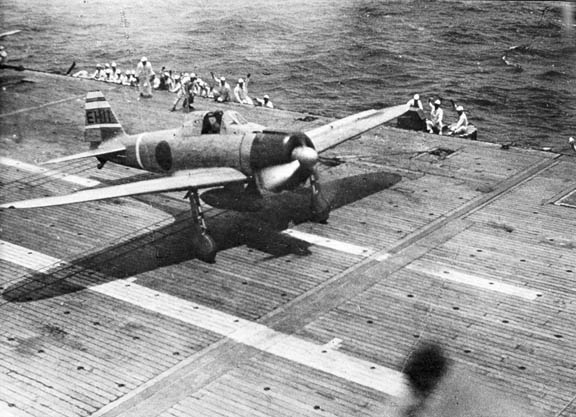WARBIRDS RESOURCE GROUP > IJARC > FIGHTERS > PREVIOUS PAGE
"Zero-Sen"

|
Type: Single-seat carrier-based fighter Float seaplane. Origin: Mitsubishi Models: A6M1 to A6M8 and Nakajima A6M2-N First Flight: A6M1: April 1, 1939 A6M2-N: December 1941 A6M5: August 1943 A6M2-K: January 1942 Service Delivery: A6M1: late July 1940 Final Delivery: N/A POWERPLANT: A6M1: Model: Mitsubishi MK2 Zuisei 13 Type: 14 Cylinder two row radial Number: One Horsepower: 780 hp A6M2: Model: Nakajima NK1C Sakae 12 Type: 14 Cylinder two row radial Number: One Horsepower: 925 hp A6M3 & A6M5*: Model: Nakajima NK1C Sakae 21 Type: 14 Cylinder two row radial Number: One Horsepower: 1,130 hp *M5 fitted with individual exhaust stacks. A6M6c: Model: Nakajima NK1C Sakae 31 Type: 14 Cylinder two row radial Number: One Horsepower: 1,130 hp Fitted with water/methanol boost to 1,210hp for emergency use. A6M8c: Model: Mitsubish Kinsei 62 Type: 14 Cylinder two row radial Number: One Horsepower: 1,560 hp DIMENSIONS: Wing span: A6M1 & A6M2: 39 ft 4½ in. (12m) Others: 36 ft 1 in (11m) Length: Landplanes: 29 ft 9 in (9.06m) Float Plane: 33 ft 2¾ in (10.13m) Height: A6M1 & A6M2: 9 ft 7 in (2.92m) Later models: 9 ft 8 in (2.98m) A6M2-N: 14 ft 1¼ in (4.3m) Wing Surface Area: N/A WEIGHTS: Empty: A6M2: 3,704 lb (1680 kg) A6M3: 3,984 lb (1807 kg) A6M5: 3,920 lb (1778 kg) A6M6c: 4,175 lb (1894 kg) A6M8c: 4,740 lb (2150 kg) A6M2-N: 3,968 lb (1800 kg) Maximum: A6M2: 5,313 lb (2410 kg) A6M3: 5,828 lb (2644 kg) A6M5 & A6M6C: 6,050 lb (2733 kg) A6M8c: 6,944 lb (3149 kg) A6M2-N: 5,423 lb (2460 kg) |
PERFORMANCE: Maximum Speed: A6M2: 316 mph (509 kph) A6M3: 336 mph (541 kph) A6M5c & 6c: 354 mph (570 kph) A6M8: 360 mph (5580 kph) A6M2-N: 273 mph (440 kph) Initial climb: A6M1, 2, & 3: 4,500 ft. (1370m)/Minute A6M5 & 6c: 3,150 ft. (960m)/Minute Service Ceiling: A6M1 & 2: 33,790 ft. (10,300m) A6M3: 36,250 ft. (11,050m) A6M5 & 6C: 37,500 ft. (11,500m) A6M8c: 39,370 ft. (12,000m) A6M2-N: 32,800 ft. (10,000m) Range with drop tank: A6M2: 1,940 miles (3,110km) A6M5: 1,200 miles (1,920km) ARMAMENT: A6M1, 2, 3, and 2-N: Two 20mm Type 99 Cannon fixed in outer wings. - Ammo: 60 rounds per gun. Two 7.7mm Type 97 machine guns above front fuselage. - Ammo: 500 rounds per gun. Wing racks for two 66 lb (30 kg) bombs. A6M5a: Two 20mm Type 99 Mk. 4 Cannon fixed in outer wings. - Ammo: 85 rounds per gun. Two 7.7mm Type 97 machine guns above front fuselage. - Ammo: N/A (probably 500 rpg). Wing racks for two 132 lb (60 kg) bombs. A6M5b: Two 20mm Type 99 Mk. 4 Cannon fixed in outer wings. - Ammo: 85 rounds per gun. One 7.7mm Type 97 machine gun above front fuselage. One 12.7mm machine gun above front fuselage. - Ammo: N/A. Wing racks for two 132 lb (60 kg) bombs. A6M5c and all later versions: Two 20mm Type 99 Mk. 4 Cannon fixed in outer wings. - Ammo: N/A. Two 13.2mm machine guns fixed in outer wings. - Ammo: N/A. One 13.2mm machine gun above front fuselage (Optional). - Ammo: N/A. Wing racks for two 132 lb (60 kg) bombs. COMMENTS: Approximately 10,450 Zero-Sen's were built with Mitsubishi building 3,880 and Nakajima building 6,570. 515 two-seat trainers (A6M2-K and A6M5-K) were also built with 279 built by Hitachi and 236 built by the 21st Naval Air Arsenal at Omura. Vast numbers of early model Zero-Sen's were expended in kamikaze attacks. |







| Variant
List: A6M1 Prototype with Mitsubishi MK2 Zuisei Radial Engine (780-hp). First flown on April 1, 1939. While an excellent performer, it failed to meet the top speed requirement set down in the Navies specifications. A6M2 A follow-up prototype to the A6M1 equipped with the Nakajima NK1C Sakae Engine (925-hp), flying for the first time in January 1940. This new configuration was so successful that in July 1940, Mitsubishi was awarded a contract to build 15 pre-production versions for evaluation in China. These trials led to the type being ordered into production at the end of July 1940, designated the Navy Type 0 Carrier Fighter Model 11 (A6M2 Model 11. There were three sub-variants built; The A6M2 Model 21 eqipped with manually folded wingtips and the A6M2-K two-set trainer. The A6M2-N was a floatplane variant built by Nakajima (327 being built). A6M3 Model 22 is equipped with the Nakajima NK1F Sakae 21 Engine. The A6M3 had clipped wings instead of folding tips A6M5 Model 52 was the major production version, introduced in 1943. Primarily designed to counter the increasingly capable Allied fighters and had several sub-variants incluuding the A6M5a, A6m5b and A6m5c which carried various armament configurations. The A6M5d-S was designed as a night fighter with a 20mm cannon mounted obliquely behind the cockpit, in the rear fuselage. The A6M5-K was a two-seat trainer A6M6c Model 53c was a re-engined version of the A6M5c put into production in late 1944. A6M7 Model 63 was developed as a fighter/bomber with a rack that could accomodate a single 250-kg (551-lb) bomb. This variant was built from mid-1945 onward. A6M8c Model
64c was the final variant but only two examples were built. The war
ended before this variant could reach production. |
Sources:
The Complete Encyclopedia of World Aircraft
WARBIRDS RESOURCE GROUP > IJARC > FIGHTERS > PREVIOUS PAGE
